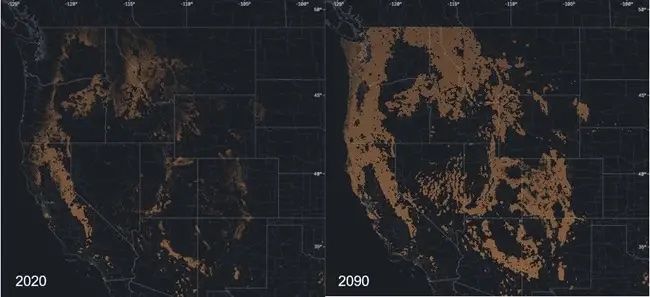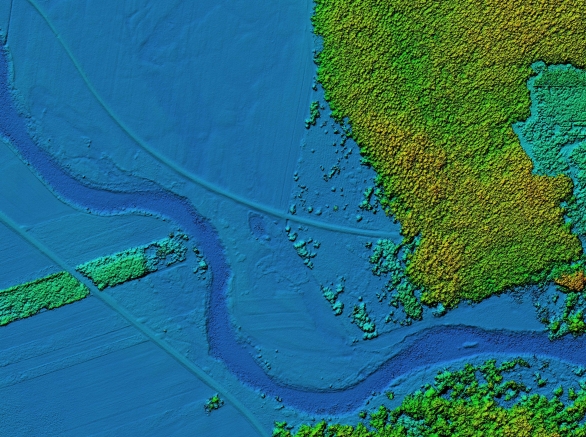October 21, 2021
Re-evaluating forest carbon offsets in the face of growing wildfire risks due to climate change
Increasingly larger areas of land in the United States have burned from wildfires since 2000. The 10 years with the largest annual areas burned have occurred since 2004, and the rate of wildfires in the western United States has increased in almost every month of the year.
As wildfires increasingly threaten forest carbon offsets, scientists are asking whether offset planning has sufficiently accounted for increased fire frequencies due to climate change. Wildfire risk is projected to increase across most of the western United States between 2020 and 2090 under a business-as-usual scenario (Figure 1).

Figure 1. Fire risk to forests in the western United States in 2020 and 2090 simulated under a medium emissions scenario (SSP3-7.0 in which emissions increase through the 21st century, similar to current expectations for global emissions given current policy commitments).
Investing in forest projects has long been a popular method for offsetting carbon footprints, and as the recent 6th Assessment Report from the Intergovernmental Panel on Climate Change has highlighted the urgency for action to reduce greenhouse gas (GHG) emissions, companies are looking for methods to reduce their environmental impact. While purchasing forest offset credits has become relatively simple, increasing scrutiny is being placed on whether forest offsets are delivering the assumed benefits.
Forest offset purchasers would be well advised to consider various climate risk assumptions in their offset credit purchases and diversify the locations of offset credit investments. Carefully selecting the location of forest offsets, critically evaluating the assumptions underlying the carbon dioxide sequestration from a forest offset, and considering the relevance of the specific forest offset to business-specific objectives can help minimize regulatory and reputational risk and better inform decision-making.
An accelerating problem
According to analyses recently released by the Congressional Research Service, the average annual acreage burned by wildfires has more than doubled since the 1990s. In 2020, 10.1 million acres of land burned in the United States, with 94% (9.5 M) of those acres in the western states of Alaska, Arizona, California, Colorado, Idaho, Montana, New Mexico, Nevada, Oregon, Utah, Washington, and Wyoming.
These statistics are particularly relevant given California's cap-and-trade program under which the California Air Resources Board (CARB) runs the largest carbon offsetting program in the United States, with several offset projects located in the western United States with increasing annual fire extents.
A forest-based carbon offset is a unit equivalent to a metric ton of carbon dioxide removed from the atmosphere from either afforestation (planting trees on open land) or reforestation (planting trees on recently cleared land), avoided forest conversion, or improved forest management. Forest carbon offsets are "among the largest-volume and lowest-cost opportunities for generating offsets."
As carbon offset forests burn in the western United States, sequestered carbon is being released — rather than sequestered — raising questions about the adequacy and longevity of the buffer pool.
Revisiting 100-year assumptions
Generally, forest carbon offsets include an extra 10 — 20% of capacity to account for losses from disease and wildfires. However, as climate change has deepened drought conditions in locations throughout the world, some scientists have questioned whether the current buffer of 10 — 20% is sufficient, while others argue that such concerns fail to consider that more acres are added to the buffer pool each time a project is developed.
Protected forests sold as carbon offsets are typically intended to sequester carbon dioxide for 100 years.
The forest projects from which CARB derives credits are spread across the United States, including the eastern U.S. where, according to the Congressional Research Service assessment, only 5% (0.5M) of the 10.1 million acres burned in 2020 were located.
If the current buffer pools are deemed insufficient, that could motivate regulatory changes which could increase the cost of these offsets. These changes could include increased forest management requirements, enhanced buffer capacity, and reduced planting density, all of which may increase the costs of offsets.
Even if changes to carbon offset regulations only impact future costs, companies will still want to consider how scientific scrutiny of past or present offset purchases may create reputational or financial risks based on negative perceptions by customers and investors.
How Exponent Can Help
Exponent offers strategic, multi-disciplinary climate consulting to public and private sector stakeholders seeking to mitigate the risks of climate factors, reduce GHG emissions and water consumption, and assess the environmental and ecological impacts of business operations. Exponent can perform and review life cycle assessments for technologies, products, and methods to better capture uncertainties and inform decision-making. Our broad expertise across numerous engineering disciplines, public health, ecological and environmental sciences, hydrology, natural resource damage assessment, and restoration and mitigation analysis gives our clients access to an unparalleled wealth of skills and resources that can help build unique solutions to unprecedented challenges.
Insights




